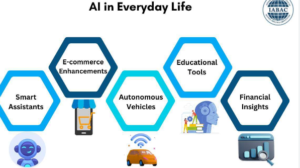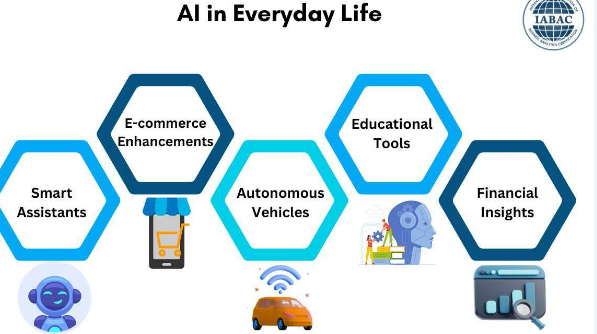AI in Our Everyday Lives: More Than Just Robots
Every time people hear something about artificial intelligence, they always think of robots or supercomputers that exist in the future. However, AI has been a part of our daily life, enabling us to think differently about communication, shopping, working, and even decision-making. From recommendation algorithms to smart home devices, AI does quite a bit to make life easier, faster, and more connected. Herein, we will look at how AI pervades everything around us, even in some very unlikely and unexpected quarters.
1. Personalized Recommendations: Your Personal Shopper
Be it surfing through a favorite streaming service or shopping online, AI continuously works in the background, analyzing consumer preference for recommendations. Whether movie suggestions based on viewers’ history of watched movies or products that would be of interest, AI recommendation algorithms track the patterns in individual behavior to present relevant content. Companies like Amazon, Netflix, and Spotify see an increase not only in user experience but also in engagement and sales.
2. Virtual Assistants: Your Digital Sidekick
From Siri and Alexa to Google Assistant, AI has come to the front and center of our homes and smartphones. They apply natural language processing to understand our voice commands and respond to reminders, smart device control, questions, and many other things. Over time, assistants learn from our interactions with them and get even better at predicting our needs and responding in ways that feel increasingly intuitive and helpful.
3. Smart Home Devices: The Building Blocks of a Smarter, Greener Home
It powers, for instance, those smart home devices that we increasingly use to keep our homes comfortable, secure, and energy-efficient. Smart appliances and lighting systems will automate based on our routines to help us reduce energy waste. From self-learning thermostats, which learn our preferred temperatures, to security cameras that detect unusual activity, AI makes our home smarter. In this regard, AI transformed the modern home into one of comfort, security, and sustainability.
4. Social Media Algorithms: The Art of Feed Curation
Facebook to Instagram down to TikTok relies on AI algorithms in creating personalized feeds that are curated based on our actions. These algorithms analyze which posts, videos, or advertisements we engage with and deliver content that aligns with our interests. The result: AI-driven personalization keeps users hooked but raises some very valid questions about information bubbles and echo chambers.
5. Smart Health and Wearables: Keeping a Tab on Our Well-being Through trackers and smartwatches, it uses AI to track vital health data such as heart rate, sleeping habits, and physical activity, on which one can generally easily apprise oneself. These wearables give insights into our health and will also detect anomalies in health that may require medical attention. Certain AI-driven apps again give personalized health counseling and routines of exercises to keep ourselves fit, allowing us to take steps for the good of health.
6. Customer Service Chatbots: AI in Business Communication
From online shopping to banking, every customer service query gets instant responses through AI-powered robots. These bots, through natural language processing, can handle general inquiries, help to carry out some transactions, and even undertake troubleshooting processes. Many companies rely on AI chatbots to enhance the effectiveness of their customer service by providing customers with quick responses while reducing any waiting periods.
7. Fraud Detection: Keeping Our Money Safe
AI guards against fraud in financial transactions by drawing analysis on transaction data and identifying unusual patterns. Anomalies can be spotted in real time using machine learning algorithms to flag probably fraudulent activities to the account holder or the bank. This application of AI protects our finances and extends that security to online transactions.
8. AI in Email: Organizing Our Inbox
With the likes of Gmail and other e-mail providers, AI schedules and prioritizes messages automatically. Spam filters, priority inboxes, and automated responses rely on AI that sifts through, sorts, and prioritizes our emails with unprecedented speed. Such AI-driven systems learn from the type of messages we open, delete, or respond to so that we can spend our time and energy focused on what really matters.
9. Navigation and Maps: Getting Us Where We Need to Go
From Google Maps to ride-sharing applications such as Uber and Lyft, AI-powered mapping and navigation have guided us through the nightmarish traffic. It does this by making route optimality calculations and estimating the time of arrival with real-time traffic data and road conditions through an AI-driven navigation system, including user input. Its ability to adapt in real time-for example, because of accidents or road closures-showcases the role of AI in making travel smoother and more efficient.
10. Content Creation and Editing Tools
AI-powered tools assist through content creation, refinement, and editing for writers, designers, and content creators. Grammarly uses AI to check grammar, tone, and clarity to help users improve their writing. Some tools offer ideas for creating content, summarizing information, or suggesting designs that actually make it easier for creators to speed up processes and focus on creativity.
11. Online Learning and Personalized Education
AI is now used for online education in creating personalized learning experiences for students at every level of instruction. By studying the performance of students, AI-driven platforms have the capability to adapt lessons in such a way that it exactly matches the particular strengths and weaknesses of every learner. AI allows virtual classrooms and makes resources available to students on demand, making education more accessible than ever.
Conclusion: AI-Everyday Partner, Rather than a Dream of the Future
AI is not solely some kind of emerging technology; instead, it’s a potent tool that easily interfaces with everyday life. From virtual assistants, health tracking, and personalized shopping to recommendations for entertainment, AI invades almost every aspect of our daily life. The more AI develops, its presence seems to surface more and more, easing life in performing everyday tasks and creating experiences tailored to personal tastes. While there are still a lot of open challenges and questions about ethics in regard to AI’s role, its application so far has shown it’s very far from being all about robots; it’s more or less a partner in making life more connected, convenient, and efficient.

Also Read :
- The Rise of AI: A New Industrial Revolution?
- Geothermal Energy: Unlocking the Earth’s Heat for a Sustainable Future
- The Rise of Solar Skins: Aesthetic Solar Panels for Urban Sustainability
- The Role of AI in Advancing Neurosurgery Outcomes
- How Blockchain is Transforming Security Across Industries
